To set up an off-grid home office, you'll need a reliable solar power system with battery storage for energy independence. Invest in energy-efficient computing equipment, like laptops and LED monitors, to minimize power consumption. Optimize lighting with solar-powered LEDs and natural light solutions. Consider climate control options that don't strain your power supply, such as passive cooling techniques. Ascertain internet connectivity through satellite or cellular networks, and have backup power sources ready. Don't forget ergonomic furniture for comfort during long work hours. With careful planning and the right equipment, you can create a productive off-grid workspace that meets all your professional needs.
Solar Power System
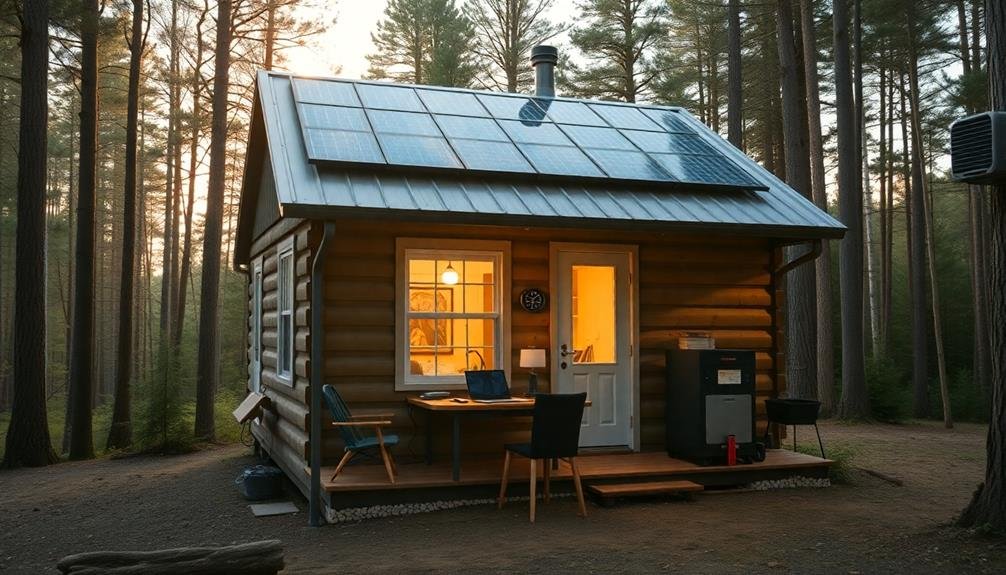
Reliability is key when it comes to powering your off-grid home office, and a solar power system is the cornerstone of energy independence. You'll need to invest in high-quality solar panels, a charge controller, and deep-cycle batteries to guarantee a consistent power supply.
Calculate your daily energy consumption to determine the size of your solar array and battery bank. Choose monocrystalline or polycrystalline panels based on your climate and budget. Install them at the ideal angle and direction to maximize sunlight exposure.
A charge controller regulates the power flow from the panels to the batteries, preventing overcharging and extending battery life. Select lithium-ion or lead-acid batteries for energy storage, considering factors like lifespan, maintenance, and cost.
Include an inverter to convert DC power from the batteries to AC power for your devices. Don't forget to incorporate a backup generator for cloudy days or high-demand periods.
Regularly maintain your solar power system by cleaning panels, checking connections, and monitoring battery health. Consider adding a smart energy management system to enhance power usage and track your system's performance.
With a well-designed solar setup, you'll have reliable, sustainable energy for your off-grid home office.
Battery Storage Solutions
When choosing battery storage for your off-grid home office, you'll need to evaluate the capacity and power output required to meet your energy demands.
You'll find two main options: lithium batteries, which are lighter and more efficient, and lead-acid batteries, which are often less expensive but bulkier.
It's essential to factor in maintenance requirements and expected lifespan, as these aspects can greatly influence your long-term costs and system reliability.
Capacity and Power Output
Battery storage solutions lie at the heart of any off-grid home office setup. When choosing a battery system, you'll need to take into account both capacity and power output.
Capacity, measured in kilowatt-hours (kWh), determines how long your batteries can power your office. For a typical home office, aim for at least 5-10 kWh of capacity to guarantee you can work through cloudy days or nighttime hours.
Power output, measured in watts, dictates how many devices you can run simultaneously. Calculate your office's power needs by adding up the wattage of all your equipment, including computers, monitors, printers, and lighting.
Don't forget to account for surge power requirements when devices start up. A 2000-3000 watt inverter should suffice for most home offices.
Think about lithium-ion batteries for their efficiency, long lifespan, and ability to discharge deeply without damage. They're pricier upfront but offer better long-term value.
Lead-acid batteries are cheaper but require more maintenance and have shorter lifespans. Whichever type you choose, make certain your battery bank can handle your daily energy consumption with some surplus for unexpected needs or future expansions.
Lithium vs. Lead-Acid Options
For off-grid home offices, choosing between lithium and lead-acid batteries is a crucial decision. Each option has its pros and cons, affecting your system's performance and longevity.
Lithium batteries offer several advantages. They're lighter, more compact, and have a longer lifespan than lead-acid alternatives. You'll get more usable capacity, as lithium batteries can be discharged to 80-90% without damage, compared to 50% for lead-acid. They also charge faster and maintain voltage better under load, ensuring stable power for your office equipment.
However, lithium batteries come at a higher upfront cost. You'll need to weigh this against their longer lifespan and better performance. They also require a battery management system to prevent overcharging or over-discharging.
Lead-acid batteries are more budget-friendly initially and have a proven track record in off-grid systems. They're also easier to recycle. But they're heavier, bulkier, and have a shorter lifespan. You'll need to replace them more frequently and be more careful about depth of discharge to avoid damaging them.
Consider your budget, space constraints, and long-term plans when choosing between lithium and lead-acid batteries for your off-grid home office.
Maintenance and Lifespan Considerations
Longevity is a key factor when choosing battery storage solutions for your off-grid home office. Both lithium and lead-acid batteries require proper maintenance to maximize their lifespan.
For lead-acid batteries, you'll need to check water levels regularly and top them up with distilled water. They're also sensitive to temperature extremes, so you'll want to keep them in a controlled environment.
Lithium batteries, on the other hand, are virtually maintenance-free but benefit from being kept at a partial state of charge when not in use.
Lithium batteries generally last longer, with a lifespan of 10-15 years compared to lead-acid's 5-7 years. However, this longer lifespan comes at a higher upfront cost.
You'll need to weigh the initial investment against the long-term savings in replacements. Consider your usage patterns too; if you'll be cycling your batteries frequently, lithium's higher cycle life becomes more valuable.
Remember to factor in the cost and effort of regular maintenance when making your decision. Proper care and monitoring of your chosen battery system will guarantee peak performance and longevity for your off-grid home office power needs.
Energy-Efficient Computing Equipment
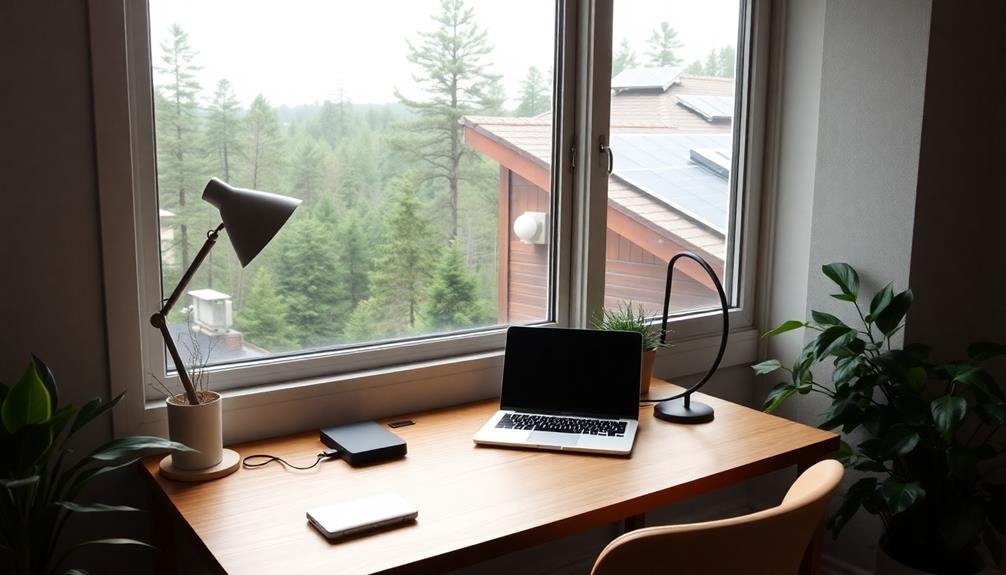
When setting up your off-grid home office, choosing energy-efficient computing equipment is essential. Start with a laptop instead of a desktop computer, as laptops typically consume less power. Look for models with Energy Star certification, which guarantees lower energy consumption.
Opt for solid-state drives (SSDs) over traditional hard disk drives, as they're more energy-efficient and faster. Consider using a tablet for tasks that don't require a full computer, as they use even less power than laptops.
LED monitors are more energy-efficient than older LCD models, so invest in one if you need a larger display. Choose a multifunction printer that combines printing, scanning, and copying to reduce the number of devices you need to power.
Don't forget about peripherals. Use a wireless keyboard and mouse to eliminate the need for constant charging or battery replacements. Invest in a smart power strip that can automatically cut power to devices when they're not in use, reducing standby power consumption.
Lighting Options
When setting up your off-grid home office, lighting is essential for productivity and comfort.
You'll want to take into account solar-powered LED systems for energy-efficient, long-lasting illumination, and battery-operated task lamps for focused work areas.
To reduce your reliance on artificial lighting, maximize natural light by positioning your workspace near windows and using reflective surfaces to distribute daylight throughout the room.
Solar-Powered LED Systems
Illuminate your off-grid home office with solar-powered LED systems for efficient and eco-friendly lighting. These systems harness the sun's energy during the day and store it in batteries for use when needed. You'll find various options, from compact desk lamps to full-room lighting solutions.
Choose LED bulbs for their energy efficiency and long lifespan. They consume less power than traditional bulbs, allowing you to maximize your solar energy storage. Look for adjustable brightness settings to customize your lighting throughout the day.
Install solar panels on your roof or in a nearby sunny spot to power your LED system. Verify you have enough panel capacity to meet your lighting needs, considering factors like average sunlight hours in your area.
Pair your panels with high-quality batteries to store excess energy for cloudy days or nighttime use.
Consider smart lighting systems that integrate with your solar setup. These allow you to control your lights remotely, set schedules, and monitor energy usage. Some systems even adjust automatically based on available sunlight, further optimizing your power consumption.
Battery-Operated Task Lamps
Task warriors in off-grid home offices can rely on battery-operated task lamps for focused lighting. These portable luminaires offer flexibility and efficiency, allowing you to illuminate specific work areas without draining your main power source. You'll find various options, from compact desk lamps to clip-on models that attach to your workspace.
When choosing a battery-operated task lamp, consider factors like battery life, light intensity, and color temperature. Look for models with long-lasting LED bulbs and rechargeable batteries to minimize waste and running costs. Some lamps even feature USB ports for charging other devices, adding versatility to your off-grid setup.
Here's a quick comparison of popular battery-operated task lamp features:
| Feature | Basic Model | Mid-Range | High-End | Eco-Friendly | Smart Lamp |
|---|---|---|---|---|---|
| Battery Life | 4-6 hours | 8-12 hours | 20+ hours | Solar-powered | 10-15 hours |
| Light Intensity | 200 lumens | 400 lumens | 800+ lumens | 300 lumens | Adjustable |
| Color Temperature | Fixed | 2 settings | Adjustable | Fixed | Adjustable |
| Extra Features | None | USB port | Dimmer | Solar panel | Wi-Fi/app |
| Price Range | $15-$30 | $30-$60 | $60-$100+ | $40-$80 | $80-$150 |
Choose a lamp that suits your specific needs and budget, ensuring you have reliable, focused lighting for your off-grid work environment.
Natural Light Maximization
Sunlight, nature's free and abundant resource, plays an essential role in off-grid home office lighting. To maximize natural light, you'll want to position your desk near windows or skylights.
Consider installing larger windows or adding a sunroom to your workspace if possible. Use light-colored, reflective surfaces on walls and ceilings to bounce sunlight around the room, brightening the entire space.
Strategically placed mirrors can also help amplify natural light, making your office feel more spacious and well-lit. Install sheer curtains or adjustable blinds to control glare while still allowing plenty of light in.
If you're building or renovating, consider incorporating clerestory windows or light tubes to bring sunlight into darker areas of your office.
Don't forget about outdoor spaces. A covered patio or deck can serve as an extension of your office during fair weather, providing ample natural light and fresh air.
Climate Control Considerations
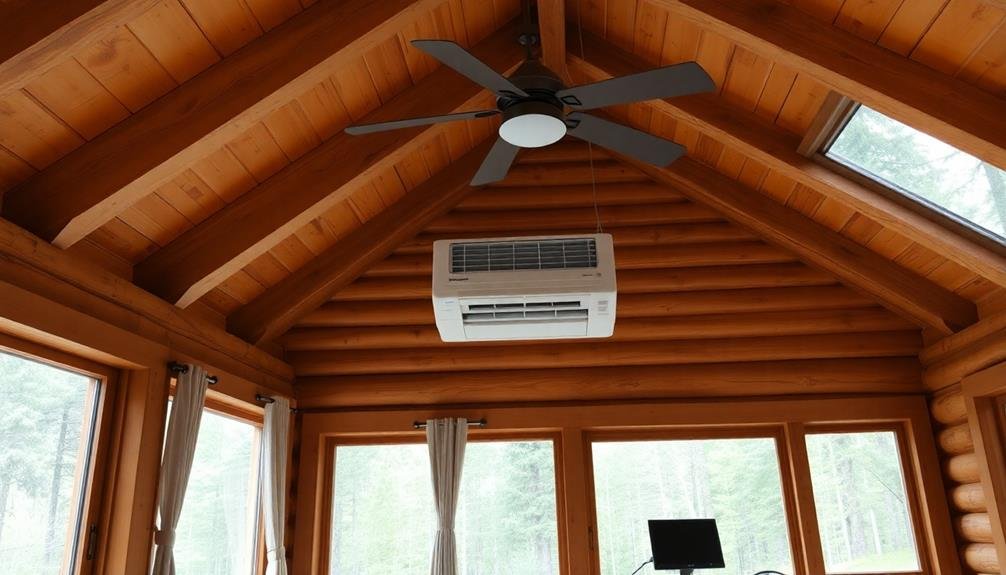
When setting up an off-grid home office, climate control is an essential factor you can't afford to overlook. Your workspace's temperature and humidity levels considerably impact your comfort and productivity. In off-grid settings, you'll need to rely on energy-efficient solutions that don't strain your limited power resources.
Consider passive cooling techniques like proper insulation, strategic window placement, and reflective roofing materials. These methods can help maintain a comfortable temperature without consuming electricity.
For heating, explore options such as solar thermal systems or wood-burning stoves, which can provide warmth without relying on the grid.
You'll also want to invest in energy-efficient fans or small, portable air conditioning units for hot days. Look for models with low power consumption and high Energy Star ratings.
To manage humidity, use dehumidifiers in damp climates or humidifiers in dry areas.
Don't forget about air quality. Install proper ventilation systems to guarantee a steady supply of fresh air. This is particularly important if you're using alternative heating methods that may produce emissions.
Internet Connectivity Solutions
Connectivity is the lifeblood of any modern home office, and it's no different for off-grid setups. You'll need to explore alternative solutions to maintain a reliable internet connection.
Satellite internet is a popular choice for remote locations, offering coverage almost anywhere. However, it can be expensive and suffer from latency issues.
If you're within range of a cell tower, 4G or 5G cellular internet might be your best bet. You can use a mobile hotspot or a dedicated cellular modem for a more stable connection.
For areas with limited cellular coverage, consider investing in a signal booster to improve reception.
Another option is point-to-point wireless internet, which involves setting up a directional antenna to receive signals from a nearby internet service provider. This solution can offer faster speeds and lower latency than satellite, but it requires line-of-sight to the provider's antenna.
Remember to factor in power consumption when choosing your internet solution. Opt for energy-efficient devices and consider implementing a backup power system to guarantee uninterrupted connectivity during periods of low solar or wind energy production.
Backup Power Sources
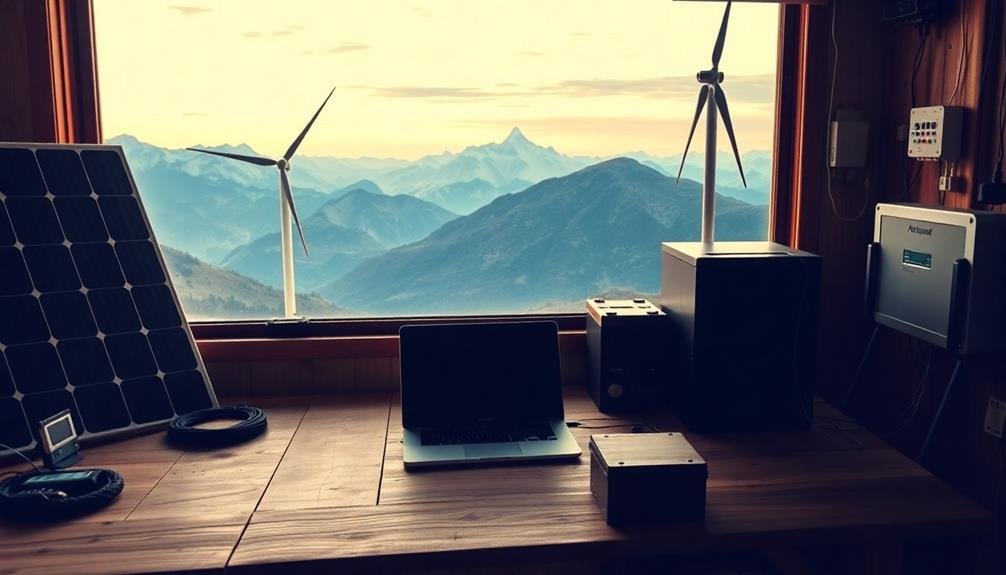
Reliable power is the backbone of any off-grid home office setup. When you're working remotely without access to the grid, you'll need to secure a constant and stable power supply for your devices.
Backup power sources are essential to keep your office running smoothly, especially during extended periods of low sunlight or unexpected equipment failures.
Consider these backup power options for your off-grid home office:
- Deep-cycle batteries: These store energy from solar panels or wind turbines and provide a steady power supply.
- Portable generators: Fuel-powered generators offer quick backup power when renewable sources aren't sufficient.
- Inverter generators: They provide cleaner power for sensitive electronics and are more fuel-efficient than traditional generators.
- Portable power stations: These rechargeable battery packs offer a silent, emission-free alternative for short-term power needs.
When choosing backup power sources, factor in your daily power consumption, the duration of backup needed, and the types of devices you'll be powering.
It's wise to have multiple backup options to guarantee you're never left without power. Regularly maintain and test your backup systems to ensure they'll work when you need them most.
Ergonomic Furniture Choices
Designed for comfort and productivity, ergonomic furniture is essential for your off-grid home office. Start with an adjustable chair that supports your lower back and promotes proper posture. Look for one with customizable height, armrests, and lumbar support to reduce strain during long work sessions.
Your desk is equally important. Choose a height-adjustable model that allows you to switch between sitting and standing throughout the day. This flexibility helps prevent fatigue and improves circulation. Consider a desk with a curved edge to support your wrists while typing.
Don't forget about proper lighting. An adjustable desk lamp with a flexible arm lets you direct light where you need it most, reducing eye strain.
For your keyboard and mouse, opt for ergonomic designs that keep your hands and wrists in a natural position. Invest in a monitor arm to position your screen at eye level, preventing neck strain. If you use multiple screens, make sure they're positioned at the same height and distance from your eyes.
Frequently Asked Questions
How Much Does It Cost to Set up an Off-Grid Home Office?
You'll find costs vary widely for an off-grid home office setup. Expect to spend $5,000 to $30,000 or more, depending on your power needs, location, and chosen technologies. Solar panels, batteries, and backup generators are major expenses to evaluate.
What Permits Are Required for an Off-Grid Home Office Setup?
You'll likely need building permits for structural changes and electrical work. Check with your local zoning office about land use permits. Don't forget environmental permits if you're installing solar panels or wind turbines. Always verify specific requirements in your area.
Can I Use Regular Household Appliances in an Off-Grid Office?
You can use regular household appliances in an off-grid office, but they'll need to be energy-efficient. You'll want to choose low-wattage options and consider DC-powered alternatives when possible to maximize your limited power supply.
How Do I Maintain and Troubleshoot Off-Grid Systems?
You'll need to regularly inspect and clean your solar panels, check battery levels, and monitor energy usage. Learn basic electrical troubleshooting, keep spare parts on hand, and consult system manuals. Don't hesitate to call professionals for complex issues.
What Security Measures Should I Implement for an Isolated Off-Grid Office?
You'll need robust physical security measures like reinforced doors, windows, and alarms. Install surveillance cameras and motion sensors. Use encrypted communication systems and secure data storage. Consider a guard dog or security personnel for added protection.
In Summary
You've now got the essentials for your off-grid home office. Remember, it's all about balancing power generation, storage, and efficient use. Don't forget to prioritize your comfort and health with proper lighting and ergonomic furniture. Stay connected with reliable internet solutions, and always have a backup power source. With these elements in place, you'll be able to work productively and sustainably, no matter how far off the grid you are.

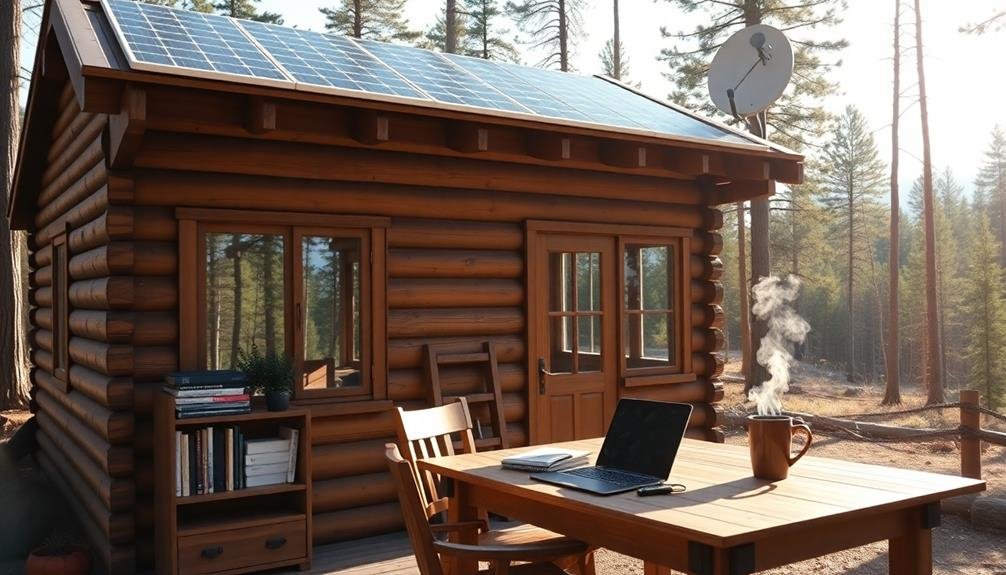
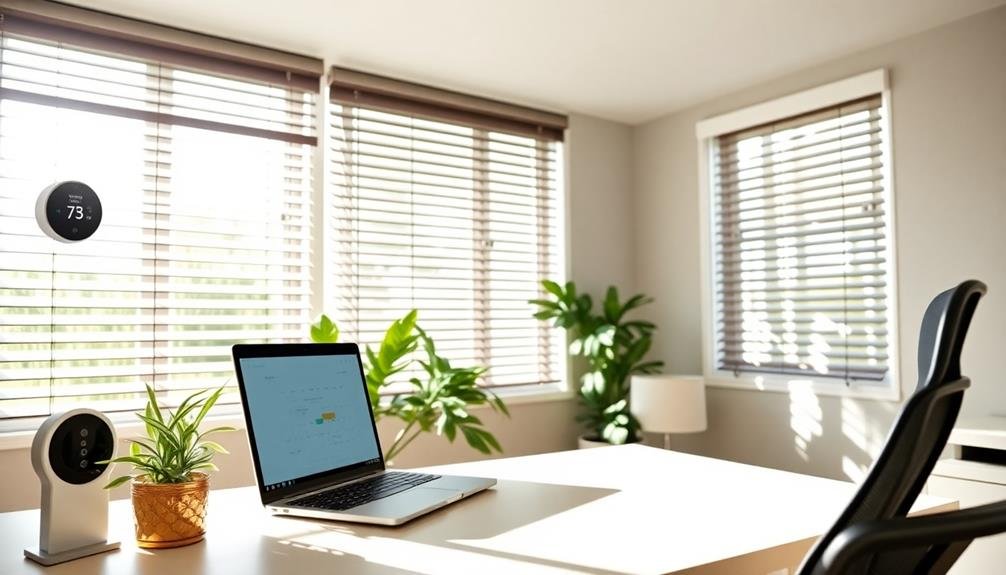
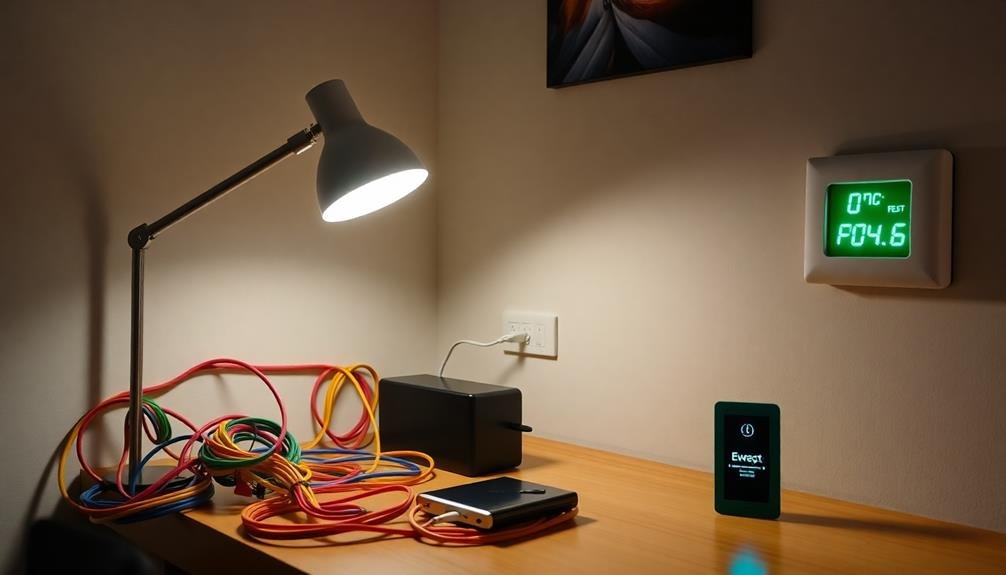
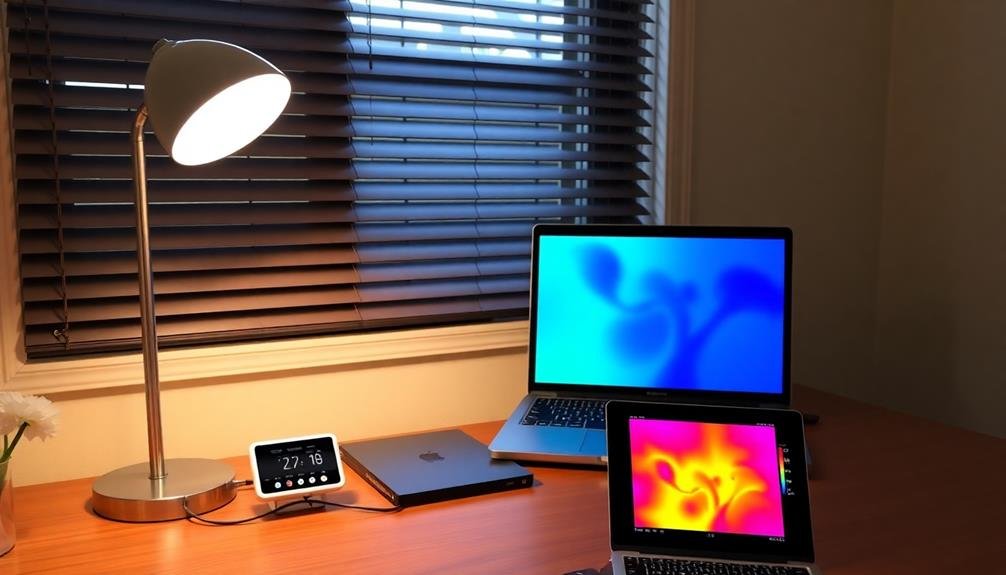
Leave a Reply